
The Enchanting Jemez Mountains: New Mexico's Hidden Gem
Discover the Jemez Mountains in New Mexico: a haven for outdoor adventures, ancient history, and serene hot springs, all set against a backdrop of stunning natural beauty.
Nestled in the heart of New Mexico, the Jemez Mountains offer a tranquil escape filled with natural beauty and cultural richness. This mountainous region is a paradise for outdoor enthusiasts, history buffs, and those seeking a peaceful retreat. The landscape is adorned with stunning red rock formations, lush forests, and hot springs, creating a diverse environment that is both inviting and awe-inspiring. Visitors can explore the Jemez Historic Site, where ancient ruins tell the story of the indigenous people who once inhabited the area. The site includes the remnants of a 500-year-old village and a mission church, providing a glimpse into the region's past. For those interested in geology, the Valles Caldera National Preserve offers an extraordinary experience. This vast volcanic crater is home to diverse wildlife, scenic hiking trails, and breathtaking views. Hot springs are one of the Jemez Mountains' most famous attractions. The soothing waters of the Jemez Hot Springs are perfect for relaxation after a day of exploring. The natural springs, set against the backdrop of the beautiful mountains, provide a serene and rejuvenating experience. Additionally, the region offers plenty of opportunities for hiking, fishing, and camping, making it an ideal destination for adventure seekers and nature lovers alike.
Local tips in Jemez Mountains
- Visit during fall to witness the vibrant autumn foliage that transforms the landscape into a colorful wonderland.
- Wear sturdy hiking boots as some trails, especially those in the Valles Caldera, can be rugged and steep.
- Stop by the Jemez Pueblo to experience the local culture and purchase traditional crafts directly from the artisans.
- Pack a swimsuit for the hot springs, but also bring a towel and water shoes for comfort.
- Check the weather forecast before heading out, as the mountainous terrain can lead to sudden changes in weather.
The Enchanting Jemez Mountains: New Mexico's Hidden Gem
Nestled in the heart of New Mexico, the Jemez Mountains offer a tranquil escape filled with natural beauty and cultural richness. This mountainous region is a paradise for outdoor enthusiasts, history buffs, and those seeking a peaceful retreat. The landscape is adorned with stunning red rock formations, lush forests, and hot springs, creating a diverse environment that is both inviting and awe-inspiring. Visitors can explore the Jemez Historic Site, where ancient ruins tell the story of the indigenous people who once inhabited the area. The site includes the remnants of a 500-year-old village and a mission church, providing a glimpse into the region's past. For those interested in geology, the Valles Caldera National Preserve offers an extraordinary experience. This vast volcanic crater is home to diverse wildlife, scenic hiking trails, and breathtaking views. Hot springs are one of the Jemez Mountains' most famous attractions. The soothing waters of the Jemez Hot Springs are perfect for relaxation after a day of exploring. The natural springs, set against the backdrop of the beautiful mountains, provide a serene and rejuvenating experience. Additionally, the region offers plenty of opportunities for hiking, fishing, and camping, making it an ideal destination for adventure seekers and nature lovers alike.
When is the best time to go to Jemez Mountains?
Iconic landmarks you can’t miss
Bandelier National Monument
Explore Bandelier National Monument, where ancient cliff dwellings meet stunning New Mexico landscapes, perfect for adventure and history enthusiasts.
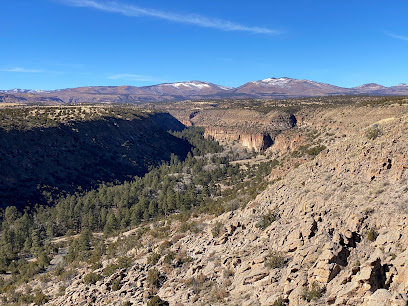
Valles Caldera National Preserve
Explore the breathtaking beauty and rich biodiversity of Valles Caldera National Preserve, a premier destination for outdoor enthusiasts in New Mexico.

Jemez Historic Site
Explore the ancient ruins and rich cultural heritage at Jemez Historic Site, a captivating historical landmark in scenic New Mexico.

Battleship Rock
Discover the awe-inspiring Battleship Rock in Jemez Springs, NM - a perfect mix of hiking, natural beauty, and cultural heritage.

Cerro Grande Route
Discover the scenic beauty and diverse wildlife of Cerro Grande Route in Jemez Springs, New Mexico, a perfect hiking destination for nature lovers.

Jemez East River Slot Canyon
Explore the stunning landscapes of Jemez East River Slot Canyon, a breathtaking hiking area in New Mexico known for its unique geological formations and serene river views.

Unmissable attractions to see
Meow Wolf Santa Fe's House of Eternal Return
Experience the magic of Meow Wolf Santa Fe's House of Eternal Return, where art, technology, and storytelling create an unforgettable adventure.

Meow Wolf Santa Fe
Discover the vibrant world of Meow Wolf Santa Fe, where immersive art and storytelling bring creativity to life in an unforgettable experience.

Sandia Peak Tramway
Experience breathtaking views and thrilling heights at Sandia Peak Tramway, a must-visit tourist attraction in Albuquerque, New Mexico.

Santa Fe National Forest
Explore the breathtaking landscapes and rich biodiversity of Santa Fe National Forest in New Mexico, a paradise for outdoor enthusiasts and nature lovers.

Santuario de Chimayo
Discover the Santuario de Chimayo, a historic shrine in New Mexico famed for its healing soil and breathtaking architecture, perfect for spiritual seekers and explorers.

Santuario de Chimayo
Discover the miraculous healing power and rich history of the Santuario de Chimayo, a serene pilgrimage site in the heart of New Mexico.

Los Alamos History Museum
Explore the fascinating history of Los Alamos, New Mexico, at the Los Alamos History Museum, where science meets culture in captivating exhibits.

Jemez Hot Springs
Experience the healing powers of nature at Jemez Hot Springs, a serene resort hotel and day spa nestled in the stunning landscapes of New Mexico.

White Rock Overlook
Experience breathtaking views and serene landscapes at White Rock Overlook, a scenic gem in New Mexico perfect for nature lovers and photographers.
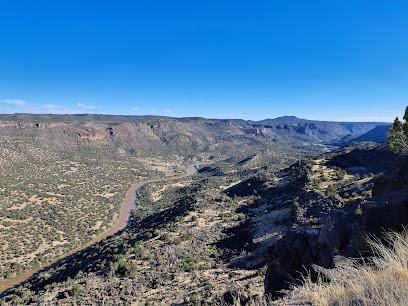
Pajarito Mountain Ski Area
Discover outdoor adventures at Pajarito Mountain Ski Area, a top destination for skiing, biking, and hiking in the heart of New Mexico.

Puye Cliff Dwellings
Explore the breathtaking Puye Cliff Dwellings, a historical site showcasing the ancient Pueblo culture amidst stunning landscapes and hiking trails.

Las Conchas Trailhead
Discover the breathtaking hiking trails of Las Conchas Trailhead in Jemez Springs, New Mexico, surrounded by stunning landscapes and rich natural beauty.
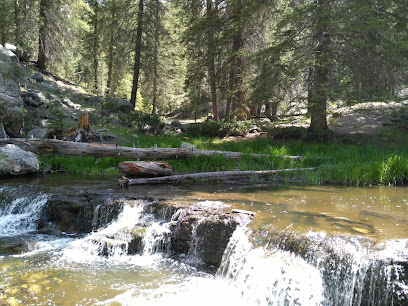
Los Alamos Nature Center, operated by PEEC
Explore the Los Alamos Nature Center, where nature, education, and adventure unite in the heart of New Mexico.

The O'Keeffe: Welcome Center
Explore the artistic legacy of Georgia O'Keeffe at The O'Keeffe Welcome Center, where art meets the stunning landscapes of New Mexico.

Valles Caldera Visitor Center
Explore the breathtaking landscapes and rich wildlife of Valles Caldera Visitor Center, your gateway to New Mexico's stunning national preserve.

Essential places to dine
Los Ojos Restaurant & Saloon
Discover authentic Southwestern cuisine with breathtaking views at Los Ojos Restaurant & Saloon in Jemez Springs.

Jemez Hot Springs
Discover relaxation at Jemez Hot Springs, where soothing mineral waters meet stunning New Mexico scenery for an unforgettable wellness retreat.

Highway 4 Cafe & Bakery
Discover comfort food and local charm at Highway 4 Cafe & Bakery in Jemez Springs – perfect for coffee lovers and adventure seekers alike.
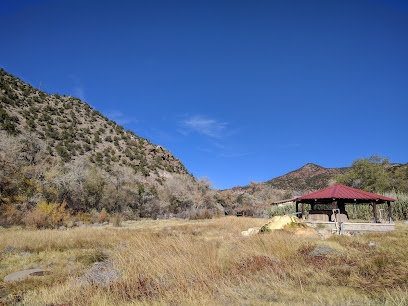
Jemez Springs Bath House
Experience ultimate relaxation at Jemez Springs Bath House—where natural hot springs meet luxurious spa treatments in scenic New Mexico.

Jemez Mountain Brewhouse
Discover gourmet pizza and craft beer at Jemez Mountain Brewhouse in scenic Jemez Springs, New Mexico - where flavor meets nature.

Subway
Enjoy customizable sandwiches and fresh ingredients at Subway in Los Alamos – perfect for a quick meal or takeout!

Canon Del Rio
Discover serenity at Canon Del Rio, where cozy accommodations meet breathtaking landscapes in Jemez Springs, New Mexico.
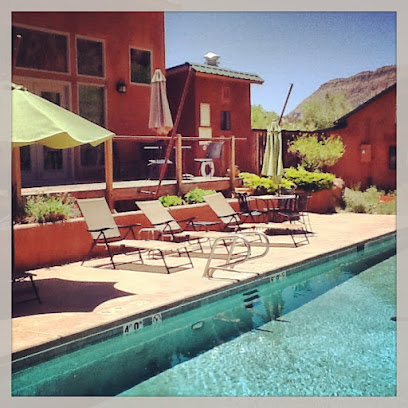
Dave's Burgers And More
Discover mouthwatering burgers at Dave's Burgers And More in Jemez Pueblo - where taste meets tradition.

Sirphey
Discover Sirphey in Los Alamos - A Fusion Restaurant Offering Delicious Takeout Options That Celebrate Local Flavors.

Joe Daddy's Grill
Experience authentic New Mexican cuisine at Joe Daddy's Grill in Jemez Pueblo - where every meal is a taste adventure.
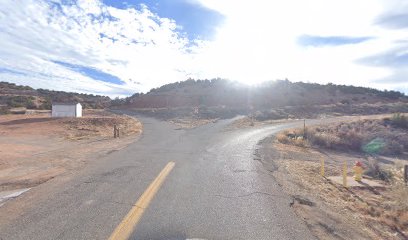
Markets, malls and hidden boutiques
Bode's General Store
Explore Bode's General Store - a unique hub for groceries, outdoor gear, and local flavors in the heart of Abiquiu, New Mexico.

Smith's Marketplace
Discover Smith's Marketplace in Los Alamos: A local grocery store offering fresh produce, gourmet foods, and unique specialties for every palate.

Jemez Soda Dam
Explore the natural beauty and unique geological wonders of Jemez Soda Dam in New Mexico, a perfect destination for nature lovers and adventure seekers.

Las Conchas Trailhead
Discover the breathtaking beauty of Las Conchas Trailhead in Jemez Springs, New Mexico, with scenic hiking trails and diverse wildlife waiting to be explored.

Los Alamos Nature Center, operated by PEEC
Explore nature, science, and local culture at the Los Alamos Nature Center, a family-friendly destination in New Mexico.

Valles Caldera Visitor Center
Uncover New Mexico's natural beauty and rich history at the Valles Caldera Visitor Center, your gateway to adventure and exploration.
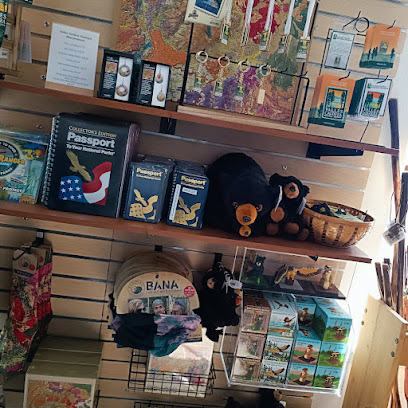
Jemez Springs Bath House
Immerse yourself in tranquility at Jemez Springs Bath House, a spa retreat where natural hot springs meet breathtaking scenery.

Camino Real Imports Santa Fe
Explore a world of unique gifts and local artistry at Camino Real Imports Santa Fe, where every piece tells a story.

Starbucks
Discover the warmth of Starbucks in Los Alamos, where quality coffee meets a welcoming atmosphere for every traveler.

Gift & Gourmet
Discover unique gifts and gourmet delights at Gift & Gourmet in Santa Fe, where local artistry meets culinary excellence.

The Chile Shop
Discover the flavors of New Mexico at The Chile Shop, a gourmet grocery store and gift shop in the heart of Santa Fe, offering local specialties and unique souvenirs.

Natural Grocers
Explore Natural Grocers in Los Alamos for a wide selection of organic produce and health foods, perfect for health-conscious travelers.

Laughing Lizard Inn
Experience a tranquil retreat at Laughing Lizard Inn in Jemez Springs, New Mexico, where comfort meets stunning natural beauty.

Los Alamos Cooperative Market
Discover Los Alamos Cooperative Market, your go-to spot for local produce, artisanal foods, and a taste of New Mexico's vibrant community spirit.

Jemez Mountains
Explore the breathtaking Jemez Mountains in New Mexico, where stunning landscapes meet rich cultural heritage and endless outdoor adventures await.

Essential bars & hidden hideouts
BOXCAR
Discover BOXCAR in Santa Fe, where delicious American cuisine meets a vibrant sports bar atmosphere and live music.

The Mine Shaft Tavern & Cantina
Experience the lively atmosphere and delicious grill cuisine at The Mine Shaft Tavern & Cantina in Madrid, NM—a true gem for tourists and locals alike.

Los Ojos Restaurant & Saloon
Experience the essence of New Mexico at Los Ojos Restaurant & Saloon, where hearty grilled meals meet a captivating Old West ambiance.

Pajarito Brewpub and Grill
Discover the heart of Los Alamos dining at Pajarito Brewpub and Grill, where local flavors meet craft beer in a vibrant atmosphere.

Pig and Fig Cafe
Discover the culinary delights of Pig and Fig Cafe, where every dish is a celebration of fresh, local flavors in a cozy setting.

Blue Window Bistro
Experience a delightful blend of local flavors and international cuisine at Blue Window Bistro in Los Alamos, NM.

Pyramid cafe
Experience authentic Mediterranean cuisine in the heart of Los Alamos, New Mexico, at Pyramid Cafe, where every dish tells a story.

The Matador
Experience the vibrant nightlife at The Matador, a beloved Santa Fe bar offering local flavors and a welcoming atmosphere.

Tonic
Discover Tonic, Santa Fe's premier cocktail bar and lounge, where creativity meets relaxation in a cozy ambiance and innovative drink selection.

Evangelo's
Experience the vibrant nightlife of Santa Fe at Evangelo's, a cocktail lounge offering expertly crafted drinks in a welcoming atmosphere.

Highway 4 Cafe & Bakery
Discover the cozy atmosphere and delicious offerings at Highway 4 Cafe & Bakery in Jemez Springs, New Mexico, perfect for travelers seeking local flavor and charm.

Boese Bros Brewpub - Los Alamos
Discover Boese Bros Brewpub in Los Alamos, where craft beer meets culinary excellence in a vibrant and welcoming atmosphere.
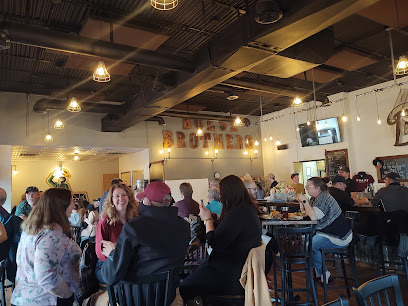
Jemez Mountain Brewhouse
Discover the perfect blend of gourmet pizza and stunning mountain views at Jemez Mountain Brewhouse in New Mexico.
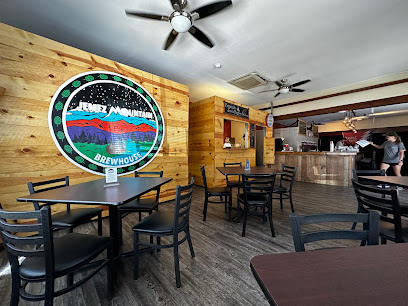
Secreto Lounge
Discover Secreto Lounge: Santa Fe's premier bar for craft cocktails and vibrant nightlife, blending local flavors with artistic ambiance.

La Fiesta Lounge
Experience the vibrant nightlife of Santa Fe at La Fiesta Lounge, where live music and signature cocktails await every visitor.

Local Phrases about Jemez Mountains
-
- HelloYá'át'ééh
[yah-ah-tay] - GoodbyeHa'áw
[ha-aw] - YesAhe'
[ah-hay] - NoDíí
[dee] - Please/You're welcomeAhe'hee'
[ah-hay-hee] - Thank youAhé'hee'
[ah-hay-hee] - Excuse me/SorryT'áá hwó'ají
[taa-hwo-ah-jee] - How are you?Yaaʼtééh kíí éí
[yah-tay kee ay] - Fine. And you?Dóó ha'íí
[doh ha-ee] - Do you speak English?Doo shił hózhǫ́?
[doh sheel hozh-on] - I don't understandDoo nihik'ehgo
[doh nee-hee-keh-go]
- HelloYá'át'ééh
-
- I'd like to see the menu, pleaseNahóóhai dooleel
[nah-ho-hai doh-lee] - I don't eat meatNaakai dahííł baa hózhǫ́
[nah-kai da-hee-ill baa hozh-on] - Cheers!T'áá hwó'ají
[taa-hwo-ah-jee] - I would like to pay, pleaseNaakai dííł
[nah-kai dee-ill]
- I'd like to see the menu, pleaseNahóóhai dooleel
-
- Help!T'áá hwó'ají
[taa-hwo-ah-jee] - Go away!T'áá hwó'ají
[taa-hwo-ah-jee] - Call the Police!T'áá hwó'ají
[taa-hwo-ah-jee] - Call a doctor!T'áá hwó'ají
[taa-hwo-ah-jee] - I'm lostT'áá hwó'ají
[taa-hwo-ah-jee] - I'm illT'áá hwó'ají
[taa-hwo-ah-jee]
- Help!T'áá hwó'ají
-
- I'd like to buy...Nahóóhai yee da
[nah-ho-hai yee dah] - I'm just lookingNahóóhai yee da
[nah-ho-hai yee dah] - How much is it?Hózhǫ́ hózhǫ́go
[hozh-on hozh-on-go] - That's too expensiveHózhǫ́ hózhǫ́go
[hozh-on hozh-on-go] - Can you lower the price?Hózhǫ́ hózhǫ́go
[hozh-on hozh-on-go]
- I'd like to buy...Nahóóhai yee da
-
- What time is it?Hózhǫ́ naaználí
[hozh-on naz-naa-lee] - It's one o'clockHózhǫ́ naaználí
[hozh-on naz-naa-lee] - Half past (10)Hózhǫ́ naaználí
[hozh-on naz-naa-lee] - MorningHózhǫ́ naaználí
[hozh-on naz-naa-lee] - AfternoonHózhǫ́ naaználí
[hozh-on naz-naa-lee] - EveningHózhǫ́ naaználí
[hozh-on naz-naa-lee] - YesterdayHózhǫ́ naaználí
[hozh-on naz-naa-lee] - TodayHózhǫ́ naaználí
[hozh-on naz-naa-lee] - TomorrowHózhǫ́ naaználí
[hozh-on naz-naa-lee] - 1T'áá
[taa] - 2Naaki
[nah-kee] - 3T'ááwó
[taa-wo] - 4Diiyin
[dee-yin] - 5Ashdla'
[ash-dlah] - 6Hastą́ą́
[has-taan] - 7Tseebíí
[tsee-bee] - 8Dįį'
[dee-ee] - 9Náhást'éí
[na-hast-ay] - 10Ná'álá'
[na-ah-la]
- What time is it?Hózhǫ́ naaználí
-
- Where's a/the...?Ahe'ózin?
[ah-hay-o-zeen] - What's the address?Hózhǫ́ naaználí
[hozh-on naz-naa-lee] - Can you show me (on the map)?Hózhǫ́ naaználí
[hozh-on naz-naa-lee] - When's the next (bus)?Hózhǫ́ naaználí
[hozh-on naz-naa-lee] - A ticket (to ....)Hózhǫ́ naaználí
[hozh-on naz-naa-lee]
- Where's a/the...?Ahe'ózin?
History of Jemez Mountains
-
The Jemez Mountains have been home to the ancestors of the Jemez Pueblo people for over 1,000 years. These ancient Puebloans built impressive cliff dwellings and large multi-story structures, remnants of which can still be seen today. The ruins of these settlements provide a glimpse into the lives of these early inhabitants, who were skilled farmers, potters, and builders.
-
In the 16th century, Spanish explorers arrived in the Jemez Mountains. The Spanish colonial period brought significant changes to the region, including missions built by Franciscan friars to convert the indigenous people to Christianity. The ruins of the San José de los Jemez Mission, constructed in the early 1600s, stand as a testament to this era of cultural exchange and conflict.
-
The Jemez Mountains played a crucial role in the Pueblo Revolt of 1680, a coordinated uprising by the Pueblo people against Spanish rule. The Jemez Pueblo was one of the many that participated in this revolt, which temporarily succeeded in driving the Spanish out of New Mexico. The revolt was a significant event in the history of Native American resistance and resilience.
-
The Jemez Mountains are renowned for their natural hot springs, which have been used for centuries by both the indigenous people and later settlers. These geothermal springs were believed to have healing properties and were an important part of the local culture. Today, they continue to attract visitors seeking relaxation and natural wellness.
-
The Valles Caldera is a 13.7-mile wide volcanic caldera within the Jemez Mountains. Formed over a million years ago by a massive volcanic eruption, the caldera is a unique geological feature and has been recognized for its natural beauty and biodiversity. It became a National Preserve in 2000, offering opportunities for scientific research, recreation, and preservation of its diverse ecosystems.
-
During World War II, the Jemez Mountains became a site of immense historical significance with the establishment of Los Alamos National Laboratory as part of the Manhattan Project. This top-secret project led to the development of the atomic bomb. The town of Los Alamos remains a pivotal location for scientific research and is steeped in historical importance related to nuclear science and technology.
-
The Jemez Pueblo community continues to thrive in the Jemez Mountains, maintaining their cultural practices, language, and traditions. The Pueblo has made significant efforts in preserving and revitalizing their heritage, including the restoration of historic sites and the promotion of cultural education. Visitors can learn about Jemez Pueblo culture through guided tours, cultural events, and the Walatowa Visitor Center.
Jemez Mountains Essentials
-
The Jemez Mountains are located in north-central New Mexico, United States. The closest major airport is Albuquerque International Sunport, approximately 70 miles (113 kilometers) to the southeast. From Albuquerque, you can rent a car and drive, which takes about 1.5 to 2 hours via US-550 N. Alternatively, there are shuttle services and limited public transportation options that connect Albuquerque to Jemez Springs, a popular entry point to the Jemez Mountains.
-
A car is the most convenient way to explore the Jemez Mountains due to the region's vast and rugged terrain. Rental cars are available at Albuquerque International Sunport and in nearby towns. Public transportation options are limited, but some shuttle services operate between key locations. Biking and hiking are popular for shorter distances and specific trail explorations. During winter, ensure your vehicle is equipped for snowy and icy conditions.
-
The official currency is the US Dollar (USD). Credit and debit cards are widely accepted in most establishments, including hotels, restaurants, and shops. However, it is advisable to carry some cash for smaller businesses, local markets, and remote areas where card payments may not be available. ATMs are available in larger towns like Los Alamos and Jemez Springs.
-
The Jemez Mountains are generally safe for tourists. However, it is essential to take standard precautions such as avoiding isolated areas at night and keeping an eye on your belongings. Outdoor enthusiasts should be aware of wildlife and changing weather conditions. There are no specific high-crime areas, but always stay vigilant and informed about local advisories.
-
In case of emergency, dial 911 for immediate assistance. Medical facilities are available in nearby towns like Los Alamos and Jemez Springs. It is recommended to have travel insurance that covers medical emergencies and outdoor activities. For minor health issues, there are pharmacies in the larger towns. Always inform someone about your travel plans, especially if you plan on hiking or exploring remote areas.
-
Fashion: Do dress in layers and wear sturdy footwear suitable for hiking. Avoid overly casual or revealing clothing when visiting cultural sites. Religion: Do respect local customs and sacred sites. Avoid loud behavior and always ask for permission before taking photos in spiritual areas. Public Transport: Do plan ahead, as public transportation is limited. Respect the schedules and be courteous to drivers and other passengers. Greetings: Do greet locals with a friendly 'hello' or 'good day.' Handshakes are common, but always be respectful of personal space. Eating & Drinking: Do try local cuisine and beverages. Don't leave food waste behind; always clean up after yourself, especially in nature areas.
-
To experience the Jemez Mountains like a local, visit the local hot springs and engage with residents who often share stories about the area's history and culture. Don't miss exploring Bandelier National Monument and Valles Caldera National Preserve for hiking and wildlife viewing. Participating in local festivals and markets will enrich your experience. Always carry a reusable water bottle and be prepared for varying weather conditions.
Nearby Cities to Jemez Mountains
-
Things To Do in Santa Fe
-
Things To Do in Sante Fe
-
Things To Do in Bernalillo
-
Things To Do in Taos
-
Things To Do in Albuquerque
-
Things To Do in Las Vegas
-
Things To Do in Pagosa Springs
-
Things To Do in Alamosa
-
Things To Do in Farmington
-
Things To Do in Durango
-
Things To Do in Socorro
-
Things To Do in Gallup
-
Things To Do in Trinidad
-
Things To Do in Ouray
-
Things To Do in Ruidoso












